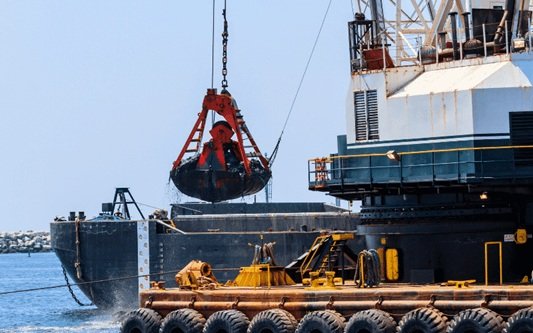Dredging construction plays a crucial role in maintaining the health and functionality of marine environments. This process involves the removal of sediment and debris from the bottom of water bodies, including rivers, lakes, and oceans. Dredging is not merely a construction activity; it is a vital operation that supports navigation, environmental restoration, and economic development. In this article, we will explore the significance of dredging in marine environments, its various applications, and the impact it has on both ecosystems and human activities.
The Basics of Dredging
Dredging is the process of excavating and removing material from the bottom of water bodies to deepen, widen, or maintain channels for navigation and other purposes. There are several types of dredging methods, including mechanical, hydraulic, and air-lift dredging, each suited for specific requirements and material types. Mechanical dredging utilizes bucket-like devices to scoop up sediment, while hydraulic dredging employs high-pressure water jets to create a slurry that can be transported through pipelines. Understanding these methods is essential for recognizing the diverse applications and implications of dredging activities in marine environments.
Enhancing Navigation and Transportation
One of the primary purposes of dredging is to enhance navigation and transportation in marine environments. Ports and harbors require regular maintenance to ensure that vessels can safely enter and exit. According to the U.S. Army Corps of Engineers, over 90% of international trade is conducted by sea, making the maintenance of shipping channels critical for economic stability. Dredging allows for the removal of silt and sediment buildup that can obstruct navigation routes, thereby preventing accidents and delays. In this way, dredging contributes to global trade and commerce while supporting local economies reliant on shipping and fishing industries.
Environmental Restoration and Habitat Creation
Dredging also plays an essential role in environmental restoration and habitat creation. In many cases, dredging is conducted as part of efforts to restore natural habitats that have been degraded by pollution, urbanization, or industrial activity. For instance, the removal of contaminated sediment can significantly improve water quality and restore the health of aquatic ecosystems. Additionally, dredged materials can be used to create new habitats, such as artificial reefs or wetlands, which support biodiversity and provide essential ecosystem services. A study published in the journal “Marine Pollution Bulletin” highlights how proper dredging practices can enhance habitat complexity and benefit marine life.
Impact on Marine Ecosystems
While dredging has numerous benefits, it is essential to acknowledge the potential environmental impacts associated with the practice. Dredging can lead to increased turbidity, which affects light penetration and can have detrimental effects on aquatic plants and organisms. Moreover, the disturbance of sediments may release harmful pollutants that have been buried for years, posing risks to marine wildlife and human health. Therefore, it is crucial for dredging projects to undergo thorough environmental assessments and to be conducted according to sustainable practices to minimize adverse effects. Recent studies emphasize the importance of monitoring and managing dredging impacts to ensure that marine ecosystems remain resilient.
Regulatory Frameworks and Best Practices
To mitigate the environmental impacts of dredging, various regulatory frameworks and best practices have been established. Governments and international organizations set guidelines that dictate when, where, and how dredging can occur. For example, the National Oceanic and Atmospheric Administration (NOAA) in the United States provides guidelines for dredging activities in sensitive marine habitats. These regulations often require comprehensive environmental impact assessments prior to initiating dredging projects, ensuring that potential risks are identified and addressed. Furthermore, adopting best management practices, such as using sediment containment systems and scheduling dredging during low-risk periods, helps to minimize disruption to marine environments.
Technological Advancements in Dredging
Advancements in technology have revolutionized the dredging industry, making operations more efficient and environmentally friendly. Innovations such as GPS-guided dredgers and automated monitoring systems allow for precise excavation and reduced disturbance to the surrounding environment. Additionally, the development of eco-friendly dredging equipment minimizes fuel consumption and emissions, further lowering the ecological footprint of dredging activities. Research from the International Maritime Organization indicates that these technological improvements not only enhance operational efficiency but also contribute to sustainable marine practices, reinforcing the importance of innovation in the dredging sector.
Economic Considerations
The economic implications of dredging are far-reaching, impacting various sectors beyond maritime trade. Dredging activities create jobs, stimulate local economies, and support industries such as tourism and recreation. For instance, maintaining navigable waterways can enhance tourism in coastal regions, attracting visitors for recreational boating, fishing, and other marine activities. According to a report by the World Bank, investments in dredging and marine infrastructure yield significant economic returns, highlighting the necessity of continued support for dredging projects as a means of bolstering economic resilience in coastal communities.
Future of Dredging in Marine Environments
The future of dredging in marine environments will likely be shaped by ongoing challenges such as climate change, population growth, and increasing industrial demands. As sea levels rise and weather patterns shift, the need for effective dredging practices to maintain coastal infrastructure and protect ecosystems will become more pressing. Additionally, as urbanization expands, ensuring that dredging operations align with sustainable development goals will be crucial. Collaborative efforts between governments, environmental organizations, and the private sector will be necessary to develop innovative solutions that balance economic growth with environmental stewardship.
Conclusion
In conclusion, dredging construction in marine environments is a multifaceted operation that serves vital purposes, from enhancing navigation to supporting environmental restoration. While it presents challenges, the implementation of sustainable practices and adherence to regulatory frameworks can help mitigate its impacts on marine ecosystems. As we move forward, embracing technological advancements and fostering collaboration among stakeholders will be essential for ensuring that dredging continues to play a positive role in our marine environments. Understanding the significance of dredging encourages us to think critically about our relationship with these vital ecosystems and our responsibility to protect them for future generations.



